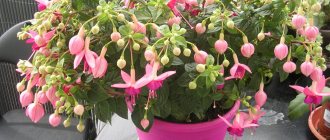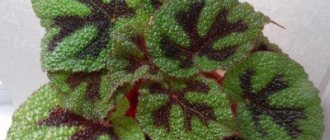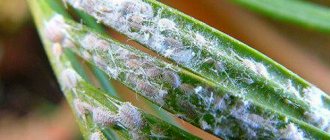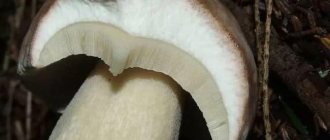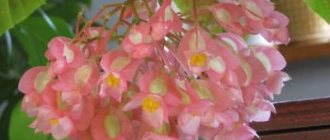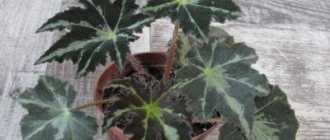Rules of care
Failure to comply with plant maintenance conditions has a detrimental effect on its development and appearance. The following signs and causes of deterioration in the condition of begonia associated with improper care are identified:
- The formation of brown spots and gray plaque on the leaves - the cause of the disease is insufficient ventilation of the room, excessive watering. It is possible that the flower is located away from the light source.
- Yellowness of the leaves - the plant does not have enough sun, a violation of the soil moisture regime.
- Shedding of leaves means little sun.
- The leaves dry out and curl - the room is too hot.
- The green cover withers and rots - excessive watering, the pot does not have a drainage layer and holes for removing excess moisture.
- The tips turn brown - the air in the room is dry.
- The leaves turn white, signs of rotting appear - excess moisture in the pot.
- When flowering, buds and leaves fall off - the plant is in a draft, excessive moisture, a sharp change in air temperature.
If all the rules for maintaining the plant are followed, you should dig deeper - perhaps a pest has settled on the begonia or it has become infected with some disease. Let's look at this issue in more detail.
Pests and their control
What pests do you have to save begonia from? Spider mites and aphids pose a danger to the plant. To defeat them, treat it with a solution made from onions. Take one liter of water and pour 15 grams of finely chopped onion into it. The solution is infused for seven days, and after filtering, the affected plant is treated with it. Treatment is stopped as soon as the pests disappear.
Snails
On a note. Garden snails are not dangerous to domestic begonias, but they can cause irreparable harm to garden dwellers.
They appear where the soil is alkaline and there is calcium, which they need to form shells. In most cases, gardeners cannot detect the pest, since it is active in wet weather and at night. After itself, it leaves a mucous secretion on the leaves.
Experienced gardeners do not fight snails, as they are orderlies in the garden. They process damaged or dead plant debris. If you don’t like the fact that they have chosen begonia, use an organic approach to combat them. If it withers, feed it with fertilizers and protect parts of the plant from the activity of snails. As a last resort, they use pesticides, dealing with them once and for all.
Aphid
A frequent and dangerous enemy of begonias is aphids. Many gardeners underestimate it, because they think that it moves little, and therefore does little harm. This is true, but partly. It multiplies quickly, feeding on begonia sap and covering its stems and leaves with sugary secretions. If you waste time, swarms of ants will soon be noticed on it. Even if this does not happen, all the leaves will be contaminated with aphids and covered with yellow spots. They will wither and fall off.
Aphids are found on the back of leaves, on young shoots, the top and buds of a charming plant. The pest, several millimeters in size, appears in the spring due to high humidity and low temperature. It is difficult to deal with aphids; it is better to prevent their appearance. The main thing is to follow all care recommendations, i.e. water on time, do not expose the pot to direct sunlight and make sure that the air temperature does not rise above +20⁰С.
For prevention, water the begonia with a nettle solution or place a box of parsley near it. When infested by aphids, the most effective remedy is to treat parts of the plant with soapy water.
Spider mite
This is a small pest with a body length of 0.1-0.3 mm. It is difficult to notice on the leaves a sucking arthropod with a yellowish or green body. It prefers the underside of leaves when the air in the room is dry and warm. Over time, they will become marbled, and through a magnifying glass they will be able to see a thin cobweb. Soon they will turn yellow and fall off.
To cope with the pest, the affected begonia is treated with Decis.
Diseases
Not many diseases affect begonia, but it is important to carry out timely treatment to prevent the death of the flower. We present to your attention the diseases of this plant, their signs and methods of rehabilitation.
Powdery mildew
First of all, let's consider what to do if powdery mildew appears on begonia. This disease is more common than others and affects all components of the plant that are located above the soil surface. The first sign of appearance is round spots with a white coating on the leaves. Over time, they grow, covering the entire plate. If no action is taken, the foliage will turn brown and fall off.
How to cure begonia from white plaque?
It is clear that it is necessary to create favorable conditions for begonia: ventilate, regularly water, provide sufficient light and temperature. Dried and diseased leaves are carefully removed from an infected begonia. If there are few foci, diseased shoots are cut off.
How to treat begonia? You can apply this treatment, maintaining a gap of a week: first, spray with a solution of potassium permanganate (2-3 g of granules, 10 liters of water), then the leaves are washed with a soapy solution of soda ash (10 liters of water, a little less than half a bar of soap, 50 g of soda). A week later, the begonia is sprayed with garlic infusion, for which 15 g of crushed cloves are taken per liter of water (the product needs to infuse for a day).
You can spray the affected begonia with a mixture of antibiotics (diluted 1:1) - penicillin tablets 100 units/ml, terramycin (same dosage). As for fungicides, Skor, Topaz, Benomyl, Anvil, Baykor, Rubigan, Vectra and other preparations of similar action are used to treat begonias against powdery mildew.
Experienced gardeners use fermented slurry to suppress the growth of powdery mildew fungus. To prepare the solution, dissolve 1 part manure in 3 parts water and leave the liquid for 3 days. Before use, you need to dilute the product in a ratio of 1:3.
Begonia pests
Loading …
When considering begonia diseases, one should also take into account pests that have a negative impact on the development of the flower. There are two main methods to combat them: mechanical or chemical. The first involves manually removing insects from the leaves and shoots of the plant, and the second involves the use of appropriate preparations by spraying.
Since in most cases begonia is grown at home, it is recommended to first turn to natural preparations for processing. They are various infusions and juices from potatoes, dry tops, garlic, onions, lemon and other elements. When it comes to harvesting herbs, it is recommended to dry them in a draft in a dark room. The product is then crushed and stored in a dry room.
Important! When using mass-produced chemicals, you need to cover your face with a bandage and wear protective clothing. In good weather, spraying is best done outside. If the procedure was performed at home, upon completion you should thoroughly wash the floor and window sill.
Greenhouse aphid
The insect is yellow or green in color, reaches 2.5 mm in length, and has no wings. Aphids suck the juice from the plant, and adults and larvae pose a danger. The female leaves up to 100 larvae at a time on the back of the leaf. Reproduction in greenhouses continues continuously. Insect death occurs at temperatures of 0 degrees and below. This is also facilitated by the heat in June with a sharp decrease in air humidity.
Now let's figure out how to fight aphids on begonias at home. A 2-4% solution of green or laundry soap is suitable for these purposes; tobacco infusion is also effective. To prepare the latter, soak 100 g of shag in a liter of heated water and let it stand for 2 days. Then the mixture is filtered and diluted with an amount of water that will be 2-2.5 times larger.
In greenhouses, a solution of soap (0.4%) or benzophosphate (0.15%) is used. Actelic (0.1%), Selecron (0.05%), and croneton solution (0.05-0.1%) have also proven themselves well.
Greenhouse whitefly
The insect has a light yellow body up to 1.5 mm long and fairly large wings. often settles on begonias grown in greenhouses, but it cannot be ruled out that it can be infected in open ground in the summer. The first signs appear on the leaves; they become discolored. The female can live up to 1 month; during this period she lays up to 500 eggs on the back of the leaf. The larvae are born after 10 days. The danger of the insect lies in the transmission of viral diseases that can completely destroy the plant.
Powdery mildew on indoor plants: prevention and treatment
Powdery mildew can occur on many types of plants, both outdoors and indoors. In indoor conditions, powdery mildew can be found on roses, gerberas, cineraria, Kalanchoe, begonias, cissus, and violets. The cause of the disease is stagnant, humid air and sharp fluctuations in room temperature.
Powdery mildew spreads when a diseased plant comes into contact with a healthy one, during watering, and is carried by insects or air flow. Treatment of powdery mildew should begin as early as possible.
Causes of powdery mildew on indoor plants
First of all, this is due to stagnant, humid air in the room and sharp temperature fluctuations. The spread of the disease also occurs through contact between sick and healthy plants, during watering, with air flow, and also when carried by insects.
Latest articles about gardening
The cause of the development of the disease can be excessive use of nitrogen fertilizers, as well as a lack of calcium in combination with high temperature and humidity in the room. At the same time, abundant watering is not at all a reason for the development of powdery mildew.
Signs of damage to indoor plants by powdery mildew
Powdery mildew (powdery mildew) is caused by powdery mildew fungi. There are many species of these fungi that parasitize a wide variety of plants, including indoor plants (for example, Oidium species). The first sign of powdery mildew appearing on your plant is a characteristic white coating on the leaves (mycelium) in the form of small shapeless spots, which is easily cleaned off.
Gradually, the whiteness takes over the stems and other parts of the indoor plant. Over time, the spots increase in size, the mycelium thickens (becomes felt), the plaque darkens and acquires a brownish color.
It should be noted that flowers can also be affected by downy mildew (downy mildew), the external signs of which are similar to real linen. But, unlike real mildew, downy mildew in the form of a coating appears only on the underside of the leaf blade, then the spots turn yellow, increase in size and then acquire a brownish color.
Folk remedies for combating powdery mildew on indoor plants
There are many folk remedies for powdery mildew that are safe for humans and plants. For example:
- soap-soda solution: dissolve 50 g of soda ash or baking soda and 20 g of liquid or grated soap in 10 liters of water and treat the plants at least twice at intervals of a week;
- whey solution: pour 1 liter of whey into 10 liters of water, stir and apply three times in dry weather with an interval of 3 days;
- kefir solution: stir 1 liter of fermented kefir or yogurt in 10 liters of water and treat the plants three times with an interval of three days;
- horsetail decoction: pour 100 g of horsetail with one liter of water, leave for 24 hours, simmer for two hours over low heat, cool, strain, dilute with water 1:5 and carry out 3-4 treatments at intervals of five days. Undiluted, the decoction is stored in a cool, dark place for about a week;
- mustard solution: dilute 2 tablespoons of mustard powder in 10 liters of warm water and spray or water the plants;
- potassium permanganate solution: dissolve 5 g of potassium permanganate in 10 liters of water. This solution stops the development of the disease and washes away the fungus from the fruit;
- ash solution: add 1 kg of wood ash to 10 liters of water, stir, leave for 7 days, carefully drain, dissolve 20 g of liquid or grated soap in the infusion and treat the plants with this composition every other day;
- garlic infusion: 50 g of garlic pulp (crushed cloves and shoots of garlic) are poured with two liters of water, infused for two days and filtered. Use the infusion undiluted;
- infusion of onion peels: 200 g of onion peels are poured into 10 liters of boiling water, infused for two days, filtered and sprayed on the plants before flowering, after it and before leaf fall.
Special chemical preparations for powdery mildew on indoor plants
If powdery mildew appears on your flowers, combating it is most effective with the help of modern fungicidal agents. They have a detrimental effect on the fungus, stop harmful processes in plant cells, protect and treat it. Spraying is carried out 1-4 times with an interval of 7-10 days (depending on the chosen drug).
Articles for flower growers
The most effective drugs for powdery mildew:
- Fundazol;
- Topaz;
- Acrobat MC;
- Previkur;
- Speed;
- Vitaros;
- Amistar extra.
A well-known fungicidal drug is phytosporin, the active ingredient of which is a concentrate of the bacteria Bacillus subtilis in a powder of chalk and humates. Despite the fact that phytosporin is considered a medicinal agent, it is practically useless against existing powdery mildew. However, as a preventive measure, it will work flawlessly.
Prevention of powdery mildew on indoor plants
Like most other plant diseases, powdery mildew is easier to prevent than to cure. Therefore, prevention is the first remedy against such a fungus. And any prevention is, first of all, correct agricultural technology. To minimize the risk of infection you should:
- regularly thin out plantings; - remove old leaves in contact with the ground; - water the plants only after the top layer of soil is completely dry; — do not abuse nitrogen fertilizers;
— carry out phosphorus-potassium fertilizing on time.
Another type of prevention against powdery mildew can be carried out in early spring, before the leaves bloom. Berry bushes and other perennials are simply scalded with boiling water. This must be done quickly, using a watering can with a diffuser. You should pour over all the branches as a whole, without lingering long in one place.
A short-term exposure to very hot water does not have time to harm plants that have not yet fully awakened after winter. But spores, mycelium, as well as pathogens of other diseases, die. A jet of steam under pressure produced using a household steam cleaner has a similar effect.
mir-ogorod.ru
Therapeutic and preventive treatment of begonia
Diseases of tuberous begonia can destroy the plant and their treatment is a necessary rescue action. In most cases, the process is performed using fungicides. These drugs destroy and stop the further spread of spores, mycelium and bacteria. Let's consider the use of different groups of drugs:
- Protective fungicides are used as preventive measures to prevent infection of healthy begonias.
- Systemic fungicides are used to protect new growth. They move through the plant’s vascular system, so they very quickly have the necessary effect.
- Medicinal fungicides are accordingly used to eliminate bacteria and spores that have managed to settle on the plant.
- Contact group preparations are designed to protect individual areas of the flower, and their effectiveness depends on the amount of precipitation.
- Treatment preparations are used to prevent diseases in planted begonias. Both seeds and tubers with bulbs are processed.
The following drugs are most effective in combating diseases: phytosporin-M, Topaz, copper sulfate, HOM, Skor, Vectra.
The information presented in the article will allow you to understand why begonia leaves curl, spots appear, the stem becomes deformed, and color is lost.
Important! It is necessary to carry out all the necessary measures to preserve the plant in a timely manner. Unfortunately, some diseases cannot be treated, and the only solution may be to destroy the begonia.
Pests more often attack plants in open spaces and in greenhouses, but their occurrence in residential areas should not be ruled out either. Often, to eliminate insects, it is enough to carry out treatment with folk remedies, without the use of chemicals.
Begonia: leaf diseases, photos, how to treat.
The main wealth of the group of leaf begonias is the pubescent leaves that appear immediately from the root. They can be not only green, but also red, yellow, white, silver and even brown, and have a variety of shapes, borders and multi-colored spots. Diseases can irreparably disrupt this splendor.
Spots and yellow rings on leaves
Such manifestations of begonia disease and subsequent deformation of the leaf blades indicate a cucumber mosaic virus, against which there are no methods of combating. All that remains is to eliminate the diseased plant as quickly as possible in order to stop the further spread of the infection.
Gray mold
It is also called gray rot. First, the leaves become covered with wet white spots with a gray coating. Subsequently, the leaf blades turn black and dry out. The cause of this begonia disease is the Botrytis fungus, the appearance and reproduction of which is promoted by dampness, which should be removed urgently. Affected areas of the plant will have to be removed. If the disease is just beginning, you can try to limit yourself to treatment with Bordeaux mixture (1 percent solution) or an aqueous mixture (1 l), laundry soap (20 g) and copper sulfate (2 g). If the result is negative, Fundazol and stronger antifungal fungicides are used - Topsin, Euparen, Polycarbacin, BMK, Rovral.
Powdery mildew
The onset of this fungal disease of begonias can be recognized by round plaques of white, flour-like plaque, which then spreads to all the leaves, which turn brown and dry out. The reason is excessive saturation of air and soil with moisture, high temperature.
Control measures include processing:
- Foundationazole (0.1% solution);
- a liquid of copper sulfate (2 g), tar soap (20 g) and water (1 l);
- ground or colloidal sulfur;
The photo shows root rot in begonia
- you can use Fitosporin, Alirin-B, Planriz;
- In particularly difficult cases, use Strobin and Topaz.
Black root rot
When plants stop growing and wilt, be sure to look at the condition of the roots. If they turn black and begin to rot, there are symptoms of black root rot - a disease that appears under conditions of excessive watering. Removing diseased roots and spraying with Benomyl will help to cope with it.
Read also: Feijoa jam with persimmon recipe
